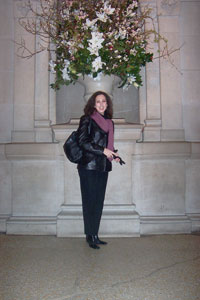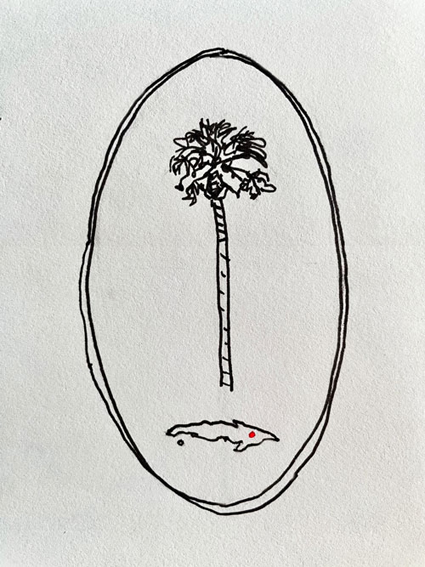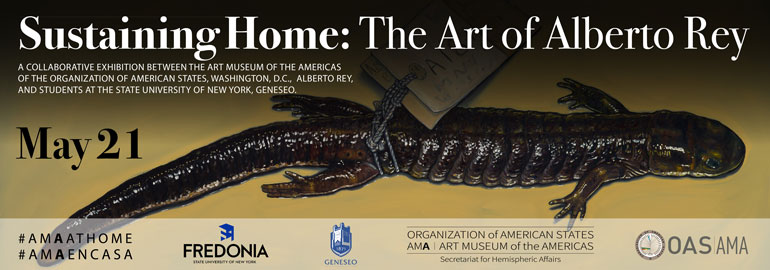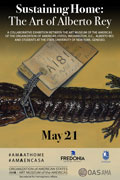
Lynette M.F. Bosch received her Ph.D. from Princeton University. Her areas of publication include: Spanish and Italian Renaissance art, as well as contemporary Latin American Art. She has written several exhibition essays on the work of Alberto Rey and edited and contributed to "Life Streams: The Cuban and American Art of Alberto Rey," SUNY Press, 2014. Currently, she is the Chair of the Art History Department at the State University of New York, at Geneseo. She is also a SUNY Distinguished Professor.
On social media May 21, 2021
Main Exhibition Essay
The Search for Home: From Exile to Preservationist
Lynette M.F. Bosch, Ph.D., SUNY Distinguished Professor, Chair, Department of Art History, SUNY Geneseo
Alberto Rey’s life began with an exile that irrevocably altered the path of his life, transforming and shaping his destiny into a universal experience as old as human history. Exile and migration have shaped the fate of individuals and groups since prehistoric humans left Africa and began to wander the Earth, populating it with the genetic diversity that rendered the peoples of our world. Stories of exiles reshaping lives into altered versions of their original fates are as old as writing, starting with The Tale of Sinuhe (c. 2000 to 1700 B.C.) - our earliest chronicle of exile. For Sinuhe, who fled from Egypt to Syria to avoid political troubles, exile brought him from high to low in an ongoing story that included great misery and great adventures.
Exile brings displacement and the loss of a first home but with the loss of first homes comes the unexpected, as new lives shape new fates and new futures replace original expectations. Exile also brings choice. Exiles must choose to either move into new lives or succumb to lives mirroring the fate of those souls found in Dante’s Inferno, who exist with their feet pointing forward, while their faces look back. Such exiles are always torn between the past - for which they long – even as they are propelled towards a future that cannot be stopped from unfolding. For Rey, exile was marked by an absence of memory, as he was taken from Cuba too young to remember his original home.
In the time of the first exiles, we, who can remember, recall how, with each departure, the change for those who stayed was as it is, when a clock ticks or a faucet drips - at first imperceptibly. Yet, with time, each tick and drip definitively changes that which had been. With each departure, slowly and inexorably, the fabric of Cuban culture transformed, eroded by those who in leaving changed life for those who remained. Preserving the world of the departing was impossible and their ebbing footsteps took with them their memories and their knowledge of the places they called home, unless they were too young to remember that which they left as they were taken out. In time, the Cuba the exiles had known disappeared, except for the ghost memories still residing in photographs or in the recall of a building, a landscape or a street that could return them, decades later, to the rush of the life that had been until it was left behind.
Rey does not remember, as we older ones do, how it was when we left Cuba, as people kept leaving, exiting from a world that changed with each departure. They left, making the same choice made by Sinuhe, who left his beloved Egypt behind for an unknown life in Syria because remaining was not an option he could explore. “Nos vamos!” (we are leaving), they said as they went, taking with them their intimate knowledge of the culture that had been in place, since their ancestors landed in Cuba. None knew what would come next and all knew what remained behind would be altered forever by their flight. So many memories lost because the storytellers didn’t stay and those who remained behind could not hold to the past, with their changing lives altered by the waves of history that would come for them. For those remaining, the world they knew diminished, as the exiles’ departures from their homes erased their lives from the island. In exile, we were as ghosts of ourselves, as we had abandoned the country, where we had been born, for an unknown fate about which we knew nothing.
Gone from our Cuban home were the good, the bad and the indifferent among us. Simultaneously deserters and survivors we went - leaving behind a decreasing number of us charged with safeguarding what had been - as the ones escaping left the remaining to carry on without them. Some remained knowing they had decided to stay with the world they called home instead of facing the unknown no matter what the future would bring. Some were too old to leave. Others would have been rejected from asylum and so they stayed. Some saw no reason to leave. But millions left in the end - and after sixty years - they still leave. The departures took away our old world and lives and the Cuba that had been disappeared into the reality of a Cuba that became. As with so many Cubans, Rey’s family was split between those who left and those who remained and it would be to those who had remained that he would eventually return to make Cuban memories that would be his own.
The details of the chronology of Alberto Rey’s life are easily told. In March of 1963, Rey’s father left Cuba for Mexico and the rest of the family joined him in August of the same year. Rey was three years old at the time, and left before he could form memories of Cuba nor does he remember Mexico City, where he was lost for a day, after he wandered off, then almost died of pneumonia. In 1965, Rey’s parents moved to the United States, settling in Miami, leaving another home he would not remember. At age seven, Rey was again moved to Barnesboro, Pennsylvania, a small coal-mining town, where his father became a Spanish teacher at the local High School. In Barnesboro, the Rey’s were the only Cubans in town. They lived in an area surrounded by the visible evidence of coal mining but also surrounded by wilderness, where Rey hiked for hours in forest areas with streams, where he liked to fish. For Rey, the natural surroundings where a neutral space that removed the social ambiguities that were part of his social life, as the family adjusted to life in the United States. Assimilation into American culture came quickly, with such assimilation punctuated by annual trips to Miami, where Rey became immersed, if briefly, in the Cuban-American culture that defined his earliest memories of Miami. The annual return to visit his Cuban family enabled him to observe Cuban culture as it was lived in exile.
By 1978, when Rey briefly enrolled at West Point Military Academy, Rey was one of millions of Cuban-Americans, whose Cuban identities were reconstructed from other people’s memories and from what could be learned from books. West Point was followed by a B.F.A, earned at Indiana University of Pennsylvania and the Art Institute of Pittsburgh and an M.F.A. from the University of Buffalo. In 1984, Rey began to travel in Latin America, Spain and Morocco, as his world opened up. As he developed his art, he took courses in Art History and Environmental Studies at Harvard. He continued traveling in Valladolid, Mexico, Isla de Mujéres, Chichen Itza and returned to Spain.
Rey’s early absence of Cuban memory was eventually filled with the demands of everyday life, in the United States, the only country he knew. For his Cuban family, time eventually veiled the loss of what had been their identity and for those on the island, living in exile became normal. In the world of Cuban exiles, to which Rey belongs, his absence of memories of his Cuban origin has been filled by a life that has taken him to home after home and to his identities as an artist, a preservationist and an active member of his Western New York State community. Since 1989, Rey and his wife, Janeil Strong, have settled in Fredonia, New York.
As Rey settled in Fredonia, his search for his personal identity became one way in which he constructed his lost Cuban identity, as he became immersed in that most American of Western New York State towns. In drives in the area, he took with Janeil, Rey explored the surrounding towns and began a series of paintings that chronicled his search for a reconciled identity.
Within Rey’s exploration of his identity, in the 1980s and the 1990’s, the subject of Cuba emerged in different groups of works that recalled Cuban food, Cuban landscapes and events that mattered most to Cubans. From the death of his grandmother, in a capsized overloaded boat, which occurred in 1980, came Rey’s series “Las Balsas.” By 1993, Cuba grew in his mind and crept into his work, forming a path to a return to his birthplace in search of new memories that could fill in what reading history and looking at old photographs could not replace – a lived experience of Cuba. In 1998, Rey returned to Cuba to see Agramonte, his birthplace and to visit the family that had remained when his parents left. On his first trip, he went with his mother and on a second trip he went with the editor of a fly fishing magazine, TomPero, on assignment.
In the late 1990s, Rey emerged as a recognized, international artist, whose work engaged global issues found in Contemporary Art, renowned for themes emphasizing identity, cultural multiplicity and the exploration of cultural landscapes, increasingly immersed in issues of environmental sustainability - with artwork included in about twenty, significant museum collection in the United States and Europe. Rey’s return to Cuba, in 1998, marked a turning point in his life that would result in his increasing involvement with preservation and environmental sustainability, alongside his exploration of his place in the American hemisphere and as an artist who could call two countries “home.” Simultaneously with this return, Rey began to work with young people in Buffalo, with the goal of developing a connection with nature for them, with a program entitled the Youth Fly Fishing Program (Sports Fishing and Aquatic Resource Educational Programming/SAREP). He continues to provide free weekly programming for the past twenty years aligned with the original program goals. Thus did his search for his Cuban identity and his return to Cuba connect with his committed involvement with American environmental concerns, eventually expanding to ongoing work with groups focused on global, water purification projects.
By the year 2000, Rey began to travel in the United States and Canada and the Caribbean pursuing a long-established practice of fishing for trout and other kinds of fish, linked to his growing commitment to environmental sustainability. His early interest in fishing the streams around Barnesboro had become linked to a growing concern about the erosion of wildlife habitat and the loss of clean water - a global problem. Becoming a recognized Fly-Fishing Guide in the United States (2020) an Orvis Fly Fishing Guide of the Year Finalist (2020), and the winner of the Orvis Guide of the Year (2021), became among the final acts of assimilation for him, as his work as a guide, an artist and a preservationist merged in a series of works focused on landscape, water and native species of fish. Rey’s concern with native habitats for flora and fauna and his observation of the life cycles of his environmental home generated multiple series of works in which he explored issues of birth, life, death and regeneration and decay – all part of his preservationist interest. In so doing, Rey merged his career as an educator (he is a State University of New York, Distinguished Professor), an artist and a preservationist.
Currently, Rey continues to work towards clean water projects near and far from his home in Fredonia, as an active preservationist working with groups committed to environmental preservation and restoration of waterways. As a result of these activities, Rey’s artistic career is intrinsically intertwined with his established identity as a preservationist and as participant in local, regional and global efforts to preserve and restore waterways and the environments through which they run. For Rey, sustaining home means living as a Cuban-American, in Western New York State, while working globally to bring attention to the social and cultural importance of nature and the need to preserve natural environments, as he did in his work in Nepal on the Bagmati River. At this point in his life, Alberto Rey is a Cuban-American artist, a preservationist, a historian and someone who works to bring about a sustainable environment for all who call this planet/place their home.
Rey’s search for his lost Cuban identity has transformed him into an artist, who has become part of a global search for the preservation of sustainable life on a rapidly changing planet. In a dialogue that began, in the 1990s, with the representation of landscapes of Western New York State (Madonnas of Western New York State) and Cuba (Madonnas in Time and Appropriated Memories) and then, after 2000, moved to portraits of the natural environments (Trout Encounters and Biological Regionalism), Rey has explored our world from a microscopic to a macroscopic perspective. The people of Cuba emerged, in the late 1990s, in his Cuban Portrait series, where he chronicled Cubans in the United States and on the island. In exploring waterways in paint and in life, Rey has traveled throughout the United States, Canada and the Caribbean. As a Cuban-American searching for global connections through water purification, Rey has documented the perils of streams and rivers in places as far apart as Buffalo, New York and Nepal. Since 2020, Rey has been painting frozen water and has become involved with the movements of icebergs, as the melting of our polar glaciers has captured his artistic and preservationist concerns.
The origin of Icebergs is found in the two trips Rey made to Iceland, one in 2003 and another in 2013, when he visited different parts of Vatnajökuli National Park, which incorporates the Vatnajökuli glacier and is a World Heritage Site, part of which is a lagoon that flows into the Atlantic Ocean. From the inception of the ice into the early Twentieth Century expansion, polar ice was a given for explorers and scientists from the North to the South Pole. That our planet was encased in ice at its tips meant that all of our world was framed by the frigid solidity of water and by stability that the frozen masses of these areas projected into the rest of the planet. Rey visited Iceland alone, with his friend Ray McLain, in 2003, and with his family, in 2013 and the changes time brought to this once, seemingly unchanging, part of the world became the catalyst for this series.
The ice of the north and the south have been prominently featured in our global imagination since Iceland was first settled, c. 874, by the Norwegian chieftain, Ingólf Arnarson. Throughout the Middle Ages, the Polar Ice became linked to a search for an ideal route that could connect the world and in the Twentieth Century, various men claimed to have reached the North Pole and, in 1937, the first North Pole Ice Station was established.
In literature, Victor Frankenstein’s creature vanished amidst the glaciers, even as the doomed scientist attempted to find and destroy his creation, driving those on board to near destruction. For writers, Ernest Hemingway coined the “Iceberg Theory,” a minimalistic writing style, where much was omitted as much was implied. In 1861, Frederick Edwin Church, the American landscape painter exhibited a painting entitled “The Icebergs,” inspired by his 1859 voyage to Newfoundland and Labrador. The painting is now in the Dallas Museum of Art and there is another version found at Olana, Church’s home on the Hudson River, in New York State. Church was not the only 19th Century artist, who explored icebergs as a subject and William Bradford’s An Arctic Summer: Boring through the Pack in Melville Bay (1871) is another example of the genre. Albert Bierstadt, Thomas Moran and Edwin Landseer also produced paintings of icebergs. Hence, in his Lost Beauty: Icebergs Series, Rey joins a group of American artists, including Bierstadt, who, like Rey, was an immigrant to the United States, who became an American landscape painter. Church’s icebergs series was known to Rey, who read about their significance for American art and who saw Church’s paintings at the Hirschhorn Museum, in Washington, D.C; at the Cooper Hewitt Museum in New York City and at the Carnegie Mellon Museum, in Pittsburgh. Additional Art Historical context for his work was found in an exhibition, The Arctic: Real and Imagined Views from the Nineteenth Century, held at the Glenbow Museum, in Alberta, Canada (2018). The exhibition was partially organized by guest Curator, James Kuptana, who intertwined European and Indigenous stories about Arctic exploration. Rey even went so far as to apply for a National Science Foundation grant for a residency in Antarctica, although that project was not pursued but his interest in icebergs increased.
For 19th Century artists, who recorded polar icebergs, the ice was an impenetrable and fixed feature of our global landscape. Today, that permanence is vanishing and the loss of our polar ice impacts every species on the planet and its implications for climate change and for the alteration of global environments is potentially catastrophic. In his “Lost Beauty: Icebergs” series, Rey has radically moved geographically far from his birth on a tropical island. Yet, the subject of his Icebergs and the fate of our planetary polar ice is one that can directly impact all of his homes. In this series, Rey combines and brings together history, experience, environmental concerns with a link to artistic traditions where ice and fate have been juxtaposed as the dramatis personae of an ongoing narrative of potential survival and pending catastrophe.
Most recently, Rey’s identities as an artist and a preservationist have taken him home to Cuba through his latest series, which features the endangered palms of Cuba. Rey began this series after reading Paul Craft’s The Palms of Cuba (2018), which catalogued the approximately hundred types of Cuban palm trees, about twenty of which are endangered. Rey was surprised to learn that there so many types of the island’s palms are endangered because Cuba’s relatively undeveloped state implies that its native species are untouched by the erosion that is part of native species destruction in the developed world. Yet, even with Cuba’s relatively restricted development, many of Cuba’s native palms are endangered. By 2020, the erosion of habitat for the palms had reached a degree where Cuba’s scientists formed a commission to work towards preventing additional loss, headed by Daylon Fundora, who is Ciego de Avila’s palm expert, that province being where the conservation efforts to save all of Cuba’s palms is centered. For Rey, Cuba’s palms became part of his preservationist and artistic concerns and he began to create a series of ceramic works with images of Cuba’s endangered palms. As his identity as a conservationist has melded with his Cuban identity, Rey has brought his search for finding a sustainable home back to his original country to which he brings his sensibilities as an artist and a conservationist.

Sketch for Endangered Palms series
Rey’s multiple identities have taken him from North to South and across the world, as he has sought a sustainable home and a defined identity. From Iceland’s glaciers, to the water of Nepal and Buffalo, New York to the palms of Cuba, Rey has melded his life, his art and his work as a conservationist in his travels from his home country to Canada, Latin America and Europe forming a series of works that express his continuing concerns with identity and his search for home, Alberto Rey continues to create art which brings together his multiple identities and his ongoing preservationist activities into a life dedicated to his concern for the sustainability of our global environment. For the Art Museum of the Americas, so closely linked to the environmental concerns of the Organization of American States, “Sustaining Home: The Art of Alberto Rey,” is an exhibition that joins the work of an artist with one of the missions of the OAS. For Alberto Rey, this opportunity has brought together his life as an educator, a sportsman, a preservationist and citizen of the countries in which he has lived and through which he has traveled as he has searched for the identities that he considers to denote his “home.”






